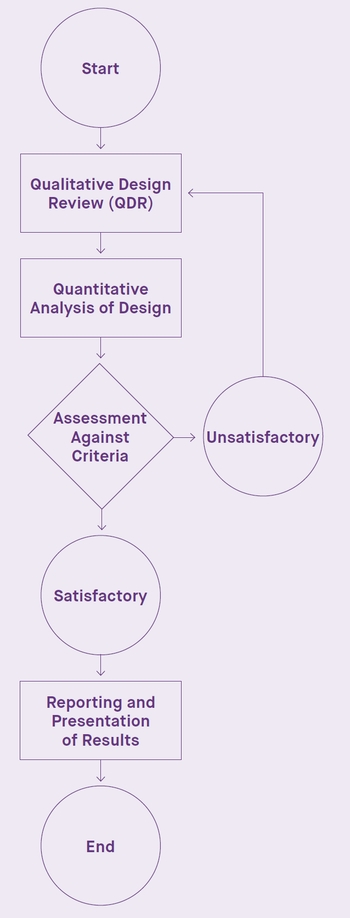Qualitative design review
introduction
A Qualitative Design Review (QDR) is a technique outlined in BS 7974-0 that allows the team to think of the possible ways in which a fire hazard might arise and establish a range of strategies to maintain the risk at an acceptable level.
When designers are engaged in complex designs, regardless of size, they may find it challenging to meet the obligations of Regulations relating to Fire Safety and allowing for fire fighting provisions. BS7974 advocates the use of QDR as a method to engage stakeholders in communication to mitigate risk.
The BS-9999 [1] t [2] fire can be challenged with other fire test data from studies relevant to the application / Trial Design under consideration.
Establishing objectives leads to discussions of life safety solutions beyond those ‘deemed to satisfy’ life safety solutions into meaningful dialogue for assets, business criticality and management decisions for resourcing and training.
Through QDR, a wide range of stakeholders understand the interdependencies between design and operations, and where emphasis on safety is needed, with a broad input from a holistic range of knowledge, engagement is critical to use the resources available effectively.
The whole building life cycle (e.g. change control, product substitution, emerging information and handover) can all be appropriately interrogated through the QDR process to arrive at acceptable solutions to mitigate hazards.
Pessimistic collaboration
The QDR team should take account of the possibility of failures of protection systems and management procedures when establishing the sequences of events to be considered. In a deterministic or comparative study, it is usual to identify a number of worst-case scenarios for further evaluation.
BS-7974-0
A whole fire event can be modelled, with different fire locations, different protection solutions, different management responses, and may include firefighting operations.
Successful QDRs are workshops, not presentations; they are delivered by team effort, not by adversarial argument; they are constructive, not divisive; they are continual, not disjointed; they are visible, not obscurantist.
QDR provides a useful benchmarking exercise against code, regulations and other requirements and recommendations.
The QDR process is flexible and can be used from feasibility right through detail design, construction safety, operations, maintenance considerations and change of use/end of use and handover.

|
| A whole fire event can be modelled, with different fire locations, different protection solutions, different management responses, and may include firefighting operations. |
This article originally appeared as ‘Building a safer future’, in Issue 128 of Architectural Technology Journal, published by The Chartered Institute of Architectural Technologists (CIAT) in Winter 2018-19. It was written by Dr Graham Smith MCIAT.
References:
- [1] Application of fire safety engineering principles to the design of buildings. Code of practice.
- [2] Fire safety in the design, management and use of buildings. Code of practice.
--CIAT
Related articles on Designing Buildings Wiki
Featured articles and news
CIOB report; a blueprint for SDGs and the built environment
Pairing the Sustainable Development Goals with projects.
Latest Build UK Building Safety Regime explainer published
Key elements in one short, now updated document.
UKGBC launch the UK Climate Resilience Roadmap
First guidance of its kind on direct climate impacts for the built environment and how it can adapt.
CLC Health, Safety and Wellbeing Strategy 2025
Launched by the Minister for Industry to look at fatalities on site, improving mental health and other issues.
One of the most impressive Victorian architects. Book review.
Common Assessment Standard now with building safety
New CAS update now includes mandatory building safety questions.
RTPI leader to become new CIOB Chief Executive Officer
Dr Victoria Hills MRTPI, FICE to take over after Caroline Gumble’s departure.
Social and affordable housing, a long term plan for delivery
The “Delivering a Decade of Renewal for Social and Affordable Housing” strategy sets out future path.
A change to adoptive architecture
Effects of global weather warming on architectural detailing, material choice and human interaction.
The proposed publicly owned and backed subsidiary of Homes England, to facilitate new homes.
How big is the problem and what can we do to mitigate the effects?
Overheating guidance and tools for building designers
A number of cool guides to help with the heat.
The UK's Modern Industrial Strategy: A 10 year plan
Previous consultation criticism, current key elements and general support with some persisting reservations.
Building Safety Regulator reforms
New roles, new staff and a new fast track service pave the way for a single construction regulator.
Architectural Technologist CPDs and Communications
CIAT CPD… and how you can do it!
Cooling centres and cool spaces
Managing extreme heat in cities by directing the public to places for heat stress relief and water sources.
Winter gardens: A brief history and warm variations
Extending the season with glass in different forms and terms.
Restoring Great Yarmouth's Winter Gardens
Transforming one of the least sustainable constructions imaginable.
























